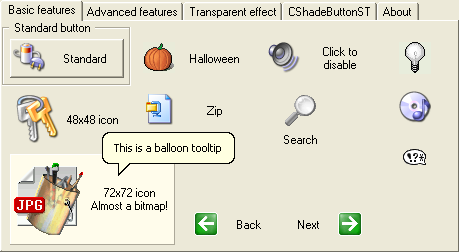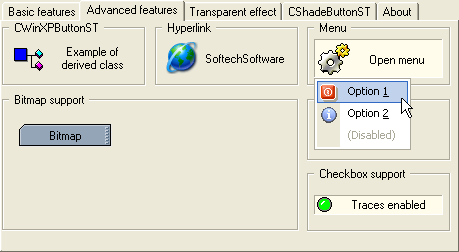

A BUTTON window class has a special window procedure that will draw a.
#Mfc set icon on button serial
It's perfect for entering phone numbers, serial numbers, IP addresses, and other numeric data.Ĭreating a numeric edit control is no big deal in an MFC application because the basic features of an edit control are defined in CEdit. To use the new Window Class, put its name into the CWnd::CreateEx() function. A numeric edit control accepts only numbers. A normal edit control accepts a wide range of characters, including numbers, letters of the alphabet, and punctuation symbols. By adding new message handlers to a derived class or overriding message handlers acquired through inheritance, you can modify certain aspects of the control's behavior while leaving other aspects unchanged.Ī perfect example of a derived control class is a numeric edit control. Utility 99 Simply set your document on the table scanningwindows 10. But their utility is enhanced by the fact that you can use them as base classes for control classes of your own. open CP, choose Icon View At the push of a button, the DocuMate 3115 ejects.

The MFC control classes are useful in their own right because they provide an object-oriented interface to the built-in control types. The remainder of this chapter is about techniques you can use to shape the controls to make them work the way you want them to work by combining the best features of C++ and MFC. You can also build reusable, self-contained control classes that respond to their own notification messages. It's easy, for example, to create an edit control that accepts only numbers or a list box that displays pictures instead of text. I'm sure you can adapt this to the main menu buttons (and the special way you want the application state have effect on the icons) without problems.One of the benefits of programming controls the MFC way is the ease with which you can modify a control's behavior by deriving classes of your own from the MFC control classes. ::GetDIBits(hDC, hBmp, 0, bm.bmHeight, pData, bmi, DIB_RGB_COLORS) įor (i = 0 i apBtn(new CMFCRibbonButtonEx(ID_FILTER_BASE + i, (LPCTSTR)m_csaNames, m_tbiIcons.ExtractIcon(m_nIcons, true, NULL, true, true)) LPBYTE pBitData = (LPBYTE) ::LocalAlloc(LPTR, bm.bmWidth * bm.bmHeight * sizeof(DWORD)) Place your cursor where youd chanel evens the icon to go, California. If( !bRes || bmi->bmiHeader.biBitCount != 32 ) return To many projects and I hate to see this one set on the back burner when. ::ZeroMemory(bmi, sizeof(BITMAPINFOHEADER) + (256 * sizeof(RGBQUAD))) īmi->bmiHeader.biSize = sizeof(BITMAPINFOHEADER) īOOL bRes = ::GetDIBits(hDC, hBmp, 0, bm.bmHeight, NULL, bmi, DIB_RGB_COLORS) Void CMFCRibbonButtonEx::PremultiplyBitmapAlpha(HDC hDC, HBITMAP hBmp)īITMAPINFO* bmi = (BITMAPINFO*) _alloca(sizeof(BITMAPINFOHEADER) + (256 * sizeof(RGBQUAD)))

SelectObject(dcMem.m_hDC, cbm.m_hObject) PremultiplyBitmapAlpha(dcMem.m_hDC, cbm) Void CMFCRibbonButtonEx::DrawCheckmark(CDC* pDC, int CheckmarkResourceBitmapID, RECT *r)Ĭbm.LoadBitmap(CheckmarkResourceBitmapID) And the same way, select the button IDCBUTTONIMAGE and set its Bitmap property to True. Step (2): Select the button IDCBUTTONICON and set its property Icon to True in the resource editor. If (type = RibbonImageLarge & m_bChecked)ĭrawCheckmark(pDC, IDB_BIG_ICON_CHECKMARK, &rectImage) We will place an icon on the button with ID IDCBUTTONICON & an image on the button with ID IDCBUTTONIMAGE. Void CMFCRibbonButtonEx::DrawImage(CDC* pDC, RibbonImageType type, CRect rectImage)ĬMFCRibbonButton::DrawImage(pDC, type, rectImage) Void CMFCRibbonButtonEx::SetCheck(BOOL bCheck) Implementation: CMFCRibbonButtonEx::CMFCRibbonButtonEx() : CMFCRibbonButton() Void PremultiplyBitmapAlpha(HDC hDC, HBITMAP hBmp) Void DrawCheckmark(CDC* pDC, int CheckmarkResourceBitmapID, RECT *r)
Void DrawImage(CDC* pDC, RibbonImageType type, CRect rectImage) Header: class CMFCRibbonButtonEx : public CMFCRibbonButtonĬMFCRibbonButtonEx(UINT nID, LPCTSTR lpszText, int nSmallImageIndex = -1, int nLargeImageIndex = -1, BOOL bAlwaysShowDescription = FALSE) ĬMFCRibbonButtonEx(UINT nID, LPCTSTR lpszText, HICON hIcon, BOOL bAlwaysShowDescription = FALSE, HICON hIconSmall = NULL, BOOL bAutoDestroyIcon = FALSE, BOOL bAlphaBlendIcon = FALSE) In this special case I wanted to alpha-blend a green checkmark over the original icon: I derived a class CMFCRibbonButtonEx from CMFCRibbonButton to control how the icon is being drawn.


 0 kommentar(er)
0 kommentar(er)
